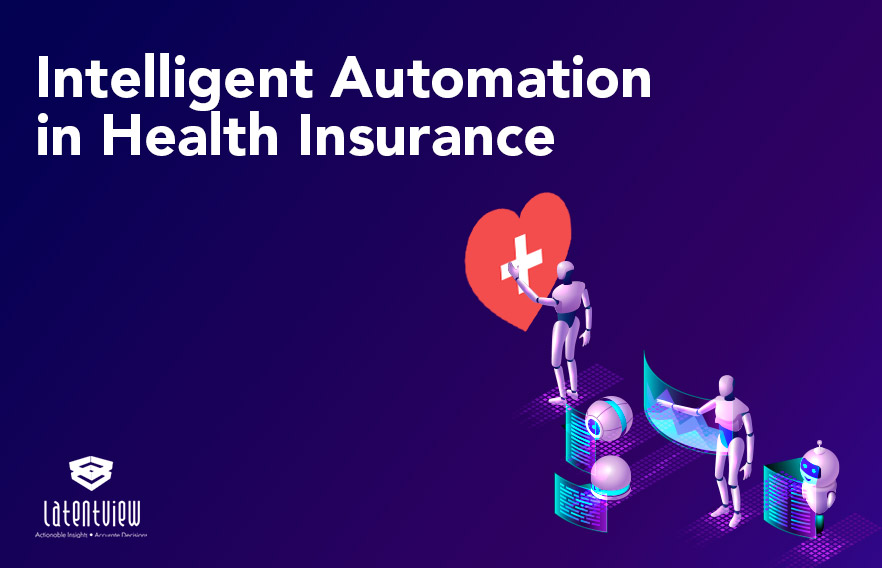Traditionally Health Insurers have been spending huge amounts of resources in automating business processes. While Automation continues to be a major focus for enterprise technology investments in post-covid-19 world, the addition of analytics-based intelligence will lower the payers’ operational costs by 30%, as per McKinsey. While companies reengineer their business processes with Intelligent Automation (IA), insurers can enhance their operational efficiency and deliver better customer experience. This article talks in detail about a few of the use cases of Intelligent Automation in Health Insurance.
Claims Management:
There are enough opportunities for automation and intelligence in claims management. In our previous blog, we discussed in detail the claims management process flow for disability insurance. In Health Insurance, clearinghouse raises the claim to insurers instead of policyholders. Activities such as coverage and eligibility checks and medical coding reviews could be the potential areas for automation. However, decision-making involved in areas such as provider and policyholder fraud assessment, benefit determination adjudication (appropriateness of the service rendered), and payment determination (partial/full) can be replaced with an Intelligence layer on top of automation.
Overpayment:
Sometimes providers have reimbursed too much money for the services provided, and this results in an overpayment. The insurer then demands reimbursement from the provider and pursues litigation if the provider does not respond. IA can be applied in an overpayment in two areas:
- Mining the high dollar claims to identify the ones that have been overpaid by the insurance carrier.
- Features determining overpayment are extracted and used to train the claims data in prepayment phase
Subrogation:
Subrogation happens typically after the payment is made to the provider. Payers identify the third-party responsible for the medical condition of the insured party and recover the money from them. IA can be applied in Subrogation in the following areas:
- Claims for subrogation are identified by mining for Current Procedural Terminology (CPT) codes related to accident, self-injury, and incidents relating to damaged/defective goods.
- Insights obtained from the process can be used to train the data with a combination of features determining successful cases. The model when applied to claims in prepayment phase results in subrogation propensity potential
Personalized Product Pricing:
With the increasing adoption of IoT in Insurance, payers can now incorporate a wide range of risk factors to accurately price products. Wearables can transform the Insurance industry from reactive to proactive. Sensor data from wearable technology directly connects insurers and policyholders and the data indicating their healthy lifestyle can be used to determine premiums. Payers can reward policyholders with healthy behaviors by offering them low premiums.
Provider Network Optimization:
Payer-Provider collaborations will be critical to success in a value-based healthcare world, where both have incentives aligned around providing the right care to the right patient at the right time. Hence it is essential for payers to select the providers carefully. Analysing the online patient reviews and testimonials (from provider websites and third-party aggregators) coupled with social listening (mentioning of providers by policyholders) can help the payers in contract negotiations and decide to retain the providers.
Contact Centre Optimization:
Contact centre is an organization’s central point for managing all customer interactions across several channels. Customers are getting more knowledgeable, and therefore the contact centres must be optimized to meet customer’s needs and expectations. IA can be applied in contact centre optimization in the following areas:
- Empowering customer service representatives with an SSOT (Single Source of Truth) that comprises consolidated information from various sources and a variety of documents
- Track user activity across multiple devices and touchpoints and identify what the customers are looking for and provide personalized support
Underwriting Fraud Prevention:
Insurance payers can reduce risks by identifying information omission or falsification by policyholders using external data during underwriting. Information provided by policyholders such as relationship status, behavioural attributes such as drinking/smoking, and non-disclosure of pets can be validated by mining social media profiles (Ex: Selfies, Relationship status).
Social Listening:
Monitoring digital conversations by customers such as tweets and social media posts can benefit payers in several ways, such as:
- Identify dissatisfied customers, engage with them and reduce churn
- Understand the expectations of customers and their pain points in existing plans and suggest upselling or cross-selling of products
- Conduct sentiment analysis on competitors to understand how the public perceives them
- Identify influencers and advocates, reach out to them and build strong relationships by rewarding them with special offers
Intelligent Automation is changing the way how Insurers and their employees complete their tasks. Three main benefits of IA in Health Insurance are lower costs, reduction in processing time, and better customer experience. We will be discussing some of the use cases in detail over the coming weeks. Watch this space to understand more about the benefits of IA in Health Insurance. To know more about LatentView Analytics’ Intelligent Automation solutions, please write to consulting@latentview.com



